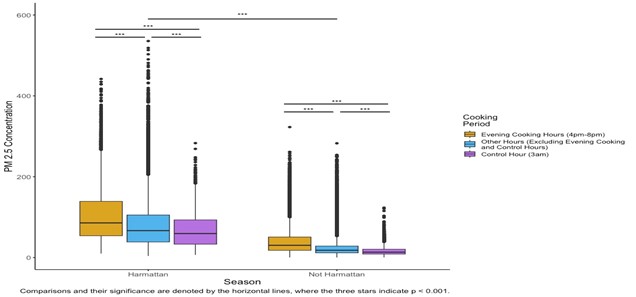KHRC Low-Cost Sensor (QuantAQ Modulair) Network, Bono East Region.
January 10, 2025 | Ongoing Project | Reading time: 8 min
Introduction and Background
Air pollution exposures are widespread, and children are uniquely vulnerable. Particles in the PM2.5 size range are small enough to penetrate deep into the lungs and even enter the bloodstream. According to the Global Burden of Disease Study 2019 from the Institute for Health Metrics and Evaluation, PM2.5 pollution–both outdoor and indoor–is the fourth highest risk factor for death globally, after high blood pressure, tobacco use, and dietary risk factors.
The goal of the Bono East Low-Cost Sensor network is to assess ambient air pollution to address critical evidence gaps and to demonstrate how early-life air pollution exposure affects health outcomes. The project is part of the Pregnancy Risk, Infant Surveillance, and Measurement Alliance (PRISMA) project, a large birth cohort study funded by the Bill and Melinda Gates Foundation and led by Kintampo Health Research Centre. Our air monitoring work will augment air pollution estimates to this already-funded birth cohort, allowing us to expand our knowledge of the relationship between early-life air pollution exposure and birth outcomes.
Investigators
Kintampo Health Research Centre: Dr. Kwaku Poku Asante, Dr. Kaali Seyram, Mr. Mujtaba Mohammed Nuhu.
Columbia University Mailman School of Public Health: Darby Jack, PhD, Steven Chillrud, PhD, Dan Westervelt.
Icahn
School of Medicine at Mount Sinai: Alison Lee, MD, MS.
Objectives
The objectives of the study are as follows:
1. To assess community particulate air pollution concentrations in 40 PRISMA cohort communities.
2. To carry out source apportionment studies in 5 PRISMA communities.
3.To carry out analyses linking ambient air pollution concentrations to child health outcomes in the PRISMA cohort.
Methodology
This study is implemented in the PRISMA/GRAPHS communities in the Bono East region of Ghana. 40 Air pollutant monitors were deployed to these study areas. Figure 2 shows the locations of the monitors.
The study will also adopt Community Engagement strategies involving stakeholder meetings with local community members and organizations to discuss the importance of environmental monitoring and data collection.
Expected Outcomes
This study expects to produce the following outcomes:
1. Network Expansion: Continue to expand the sensor network to cover additional areas within the middle melt of Ghana.
2. Enhanced Data Analysis: Collaborate with
local and international universities to conduct more in-depth data analysis and research.
3. Policy Advocacy: Use collected data to advocate for improved environmental policies and practices at the rural and urban levels.
4. Sustainability Planning: Develop a sustainability plan to ensure the ongoing operation and maintenance of the sensor network.
Preliminary Findings
Preliminary findings indicate an increase in air pollutants during the dry season, which can be attributed to the dust from harmattan winds. Figure 3 below presents the grand averages of particulate matter (PM) concentrations over the study period. The first panel shows the mean PM1 concentration, which averages 40.8 µg/m³, the second panel displays PM2.5 data, averaging 48.9 µg/m³, and the third panel presents PM10 levels, with a mean concentration of 137 µg/m³.


Each panel indicates periods of elevated PM levels, with noticeable peaks occurring during the dry season, likely attributable to increased dust from Harmattan winds. Notably, the PM1, PM10, and PM2.5 values trend together over time, suggesting that the sources influencing particulate matter levels affect all size fractions similarly.
Figure 4 above also examines the relationship between seasonal harmattan, peak evening cooking times, and air pollution. For this analysis, Harmattan was defined from December 1st to March 1st. Primary cooking hours were defined as 4–8 pm, although it is worth noting that the heatmap in Figure 4 suggests that the fires smoke for some time after the actual cooking is completed, leading to continued increased PM content beyond 8 pm. With this effect in mind, the pollution levels during evening cooking hours were compared to both a control hour defined as 3–4 am, a period sufficiently after evening cooking and before morning meal preparation to ensure it is unaffected by cooking activities, and all other times of the day/night (excluding both the cooking hours and the control hour).
PM2.5 concentration was higher (M = 84.4, SD = 59.8) during Harmattan months than non-Harmattan months (M = 26.2, SD = 23.9), with the difference statistically significant (p < 0.001). There was also a statistically significant (p < 0.001) difference in PM2.5 concentration levels between cooking and non-cooking hours — PM 2.5 concentration was higher (M=5 9.8, SD=5 5.3) during cooking hours than during other hours (M=4 1.3, SD=4 5.0) or the control (M=3 2.2, SD=3 5.3).
Funder: Clean Air Fund.
Study Duration : Three (3) Years
Start Date : September 2023
End Date : August 2026
Conclusion
The establishment of the Low-Cost Sensor Network in the Bono East Region represents a significant step toward improving environmental monitoring and public health. The project has successfully engaged local communities and is consistently collecting valuable data to support informed policy decisions and promote healthier living environments.
